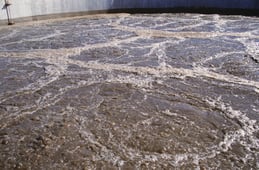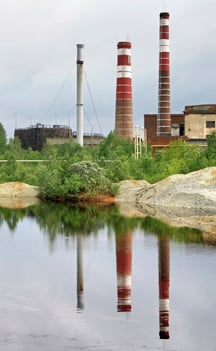.jpg?width=295&height=149&name=Wastewater%20Produced%20at%20Coal-Fired%20Utilities_Blog%20Social%20Media%20Image%20(2).jpg)
President Biden’s Executive Order 13990 directed the U. S. Environmental Protection Agency to undergo a policy and regulation review of changes to the Clean Air Act set forth during President Trump’s administration. The order instructed the EPA to suggest revisions and/or cancellation of regulations and policies that at first glance do not seem to be in the best interest of public health.
The proposed EPA rule is in relation to a legal settlement brought in a suit by several public interest groups. The EPA in July of 2021 announced its intent to develop the rulemaking for wastewater generated by coal-fire utilities. The rule would revert the standards to the 2015 rule initiated during the Obama/Biden administration.
 As stated in the Federal Register (18440 Federal Register / Vol. 88, No. 60 / Wednesday, March 29, 2023 / Rules and Regulations), “This rule is effective on May 30, 2023, without further notice, unless EPA receives adverse comment by April 28, 2023. If EPA receives adverse comment, the Agency will publish a timely withdrawal in the Federal Register informing the public that the rule will not take effect.” EPA did receive adverse comment, and the rule-making review therefore continues.
As stated in the Federal Register (18440 Federal Register / Vol. 88, No. 60 / Wednesday, March 29, 2023 / Rules and Regulations), “This rule is effective on May 30, 2023, without further notice, unless EPA receives adverse comment by April 28, 2023. If EPA receives adverse comment, the Agency will publish a timely withdrawal in the Federal Register informing the public that the rule will not take effect.” EPA did receive adverse comment, and the rule-making review therefore continues.
Keeping to their word of developing a rule for coal-fired utilities, the EPA issued a news release in March of 2023 announcing that the current administration is proposing a reduction of greater than 580 million pounds of pollution per year in water sources by targeting wastewater from coal-fired utilities. As stated by the EPA, coal-fired plants potentially discharge large volumes of wastewater into the environment. Within the waters discharged are pollutants such as selenium, nickel, mercury, chloride, bromide, nutrient pollution, and total dissolved solids (TDS).
The administration’s proposal states that the administration is to follow the latest science and evokes the EPA’s authority per the Clean Water Act. The Clean Water Act falls under the authority of the EPA to review, monitor, and set limits for a myriad of pollutants and toxic metals, including mercury, released into the environment that may make their way into the air, rivers, streams, lakes, and other bodies of water in the environment. The EPA’s new rules would limit contaminants into an estimated 100 bodies of water. One of the target pollutants of the proposal is nutrient pollutant, which can cause harmful blooms of algae downstream from the discharge source.
 The EPA also stated that utilities that operate coal plants could declare to stop burning coal by 2028 to avoid having to install expensive improved pollution control technologies. In the past few years, utilities with ageing coal-fired plants have announced that they will be shuttering their ageing plants by 2028. Some plants that installed less expensive pollution technologies prior to the EPA announcement may be allowed to operate until 2032, and others might be able to extend the shutdown to convert to natural gas date to 2029 from 2028.
The EPA also stated that utilities that operate coal plants could declare to stop burning coal by 2028 to avoid having to install expensive improved pollution control technologies. In the past few years, utilities with ageing coal-fired plants have announced that they will be shuttering their ageing plants by 2028. Some plants that installed less expensive pollution technologies prior to the EPA announcement may be allowed to operate until 2032, and others might be able to extend the shutdown to convert to natural gas date to 2029 from 2028.
The targeted sources for the EPA limit-enhancements are flue gas desulfurization wastewater, bottom ash water and leachates from combustion residuals. The proposal classifies these sources as legacy and seeks comments on stricter standards for the mentioned wastewaters. The rule also calls for monitoring and cleanup requirements for legacy ash landfills and waste ponds. Some of these legacy sites were excluded from previous rules.
As stated, one of the pollutants monitored is the heavy metal mercury. Mercury pollution is very problematic as it migrates through the environment. Mercury is most devastating to human and animal life forms as organic mercury, particularly the stable compound of methyl mercury.
The public comment period closed on May 30, 2023, and a next step is to officially set the levels of determination for mercury, and the discharge levels from the point sources listed in CFR 40 Part 423, such as flue gas desulfurization (FGD) wastewater, flue gas mercury control wastewater, transport water, gasification wastewater, and combustion residual leachate.
The levels will be based on “Best Available Technology Economically Achievable (BAT)” levels. The best available technologies are those used within the steam generation utilities to remove the heavy metals, including mercury, and other pollutants from the waste streams. The point sources are and/or can be very difficult matrices to analyze, so each has its own discharge limits. They can be as low as a daily value of ≤ 1.8 ng/L with a 30-day running average of ≤ 1.3 ng/L. The BAT lower limits are aligned with concentrations determined using Cold Vapor Atomic Fluorescence (CVAF), while the upper BAT limits may be suited for Cold Vapor Atomic Absorption (CVAA).
 The EPA has proposed compliance paths that would encourage the retirement of coal-fired utilities and/or the stoppage of burning coal by switching to other combustion sources, such as natural gas, by 2028. Power plants that are in the compliance process with existing regulations that plan to stop burning coal would be granted compliance with the proposed rule.
The EPA has proposed compliance paths that would encourage the retirement of coal-fired utilities and/or the stoppage of burning coal by switching to other combustion sources, such as natural gas, by 2028. Power plants that are in the compliance process with existing regulations that plan to stop burning coal would be granted compliance with the proposed rule.
The proposed rule will support the protection of our vital water resources for generations to come. The protection is critical for our individual livelihood and the health of our communities. We need and use clean water for drinking, agriculture, recreation, and industry. And without clean water, all industries would suffer and/or collapse.
There is a potential issue with waters drained and/or leached out of legacy wastewater ponds. The EPA has stated that this is a site-by-site issue, which could mean that states or local entities will be calling the shots. The EPA plans to issue its final rule in spring 2024 and estimates that the average American household will see an annual energy cost increase of just 63 cents. If that estimate is correct, it’s insignificant to consumers of all incomes. Historically, these types of power generation plants are in rural areas. Thus, according to the EPA, low-income communities would gain the most by a cleaner overall environment.
 The new proposal on water discharged into the environment sets into motion a further decline of coal consumption. This will affect the coal-reliant states and push them toward alternative energy sources, such as wind and solar. There is a short-term human cost as well, with the loss of employment resulting in financial insecurity for families as the power utilities transition away from coal. The EPA administrator indicated that a specific outcome is not the intent of the rule; it is about public health and the quality of our waterways.
The new proposal on water discharged into the environment sets into motion a further decline of coal consumption. This will affect the coal-reliant states and push them toward alternative energy sources, such as wind and solar. There is a short-term human cost as well, with the loss of employment resulting in financial insecurity for families as the power utilities transition away from coal. The EPA administrator indicated that a specific outcome is not the intent of the rule; it is about public health and the quality of our waterways.
Teledyne Leeman Labs has multiple products capable of analyzing mercury concentrations in wastewater and in coal products. Please visit the Resources section of https://www.teledyneleemanlabs.com to read Application and Technical Notes on this topic.
For more information on Leeman Labs Mercury Analyzers or if you would like to someone to contact you - click the button below.

